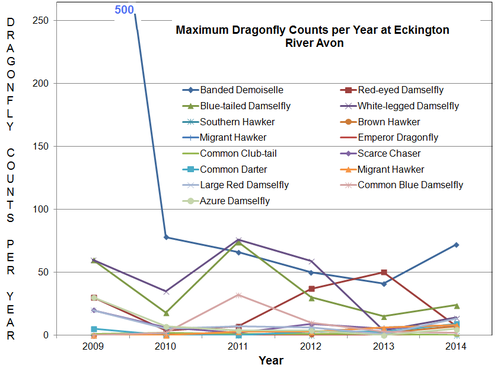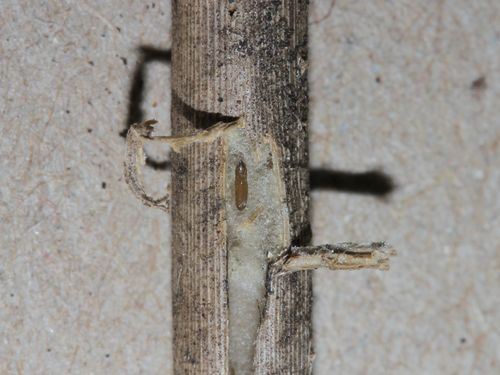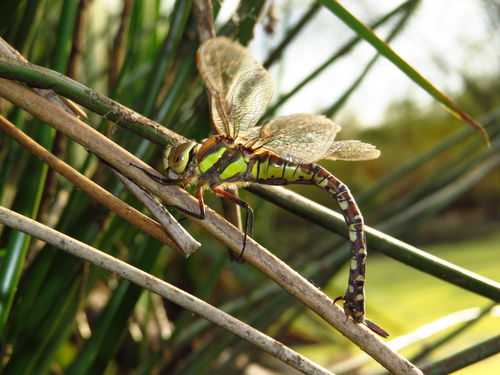Dragonflies in Worcestershire 2014
Mike Averill
Following the previous year’s prolonged cold spring right in to May, the weather in 2014 was more like a normal year with gradually increasing temperatures through April and May. Through the year 24 species were seen out of the 28 so far recorded in the county. Nearly all species emerged earlier than last year and a few were actually earlier than in the 2008-12 period, namely the Common Club-tail Gomphus vulgatissimus and Scarce Chaser Libellula fulva. It’s worth noting that 13 of our Dragonflies and three of our Damselflies emerge early in spring as a synchronised event. These are usually species that have at least a two year cycle but delay emergence through the previous Autumn and wait until the following year to enable them to emerge early in the next April/May. All the early synchronised species are very susceptible to poor weather and can easily vary their first dates by as much as three weeks.
As the year progressed in to 2014, the weather was occasionally fine and memories of the summer are likely to be good with long spells of fine weather (16 dry days in June, 23 in July, 11 in August and 23 in September), yet as a year it was very wet and September was the only month with below average rainfall. This continuation of regular rain was ideal for dragonflies, wet enough to keep pools full yet with long dry sunny spells allowing the adults to fly regularly. This is good weather for aquatic insects but perhaps not so good for butterflies and bees.
Recording transects are a really useful way to get a meaningful trend in dragonfly numbers through the year, which can in turn be compared to other years. Taking counts over a measured distance and repeating the visit each month in good weather can give a better idea of numbers where subjective impressions cannot. In the case of the counts on the River Avon at Eckington, most species had an upturn in numbers compared to last year, the only exception being the Red-eyed Damselfly Erythromma najas. This upturn followed a two year decline in 2012 and 2013 for the White-legged Platycnemis pennipes, Blue-tailed Ischnura elegans and Common Blue Enallagma cyathigerum damselflies (01). Species with too small a count to see on the graph like Scarce Chaser, Common Darter Sympetrum striolatum and Large Red Damselfly Pyrrhosoma nymphula also had a slight upturn. Another species that has recovered a little in 2014 after a large decline from 2009 is the Banded Demoiselle Calopteryx splendens. It is not clear why 2009 was such a good year for this species but it did have a very warm Spring followed by long hot spells in the summer. Whatever the reason, the species has not done nearly as well since.
In Croome Park all species were also up this year, recovering from a poor 2013. The Small Red-eyed Damselfly Erythromma viridulum did very well indeed this year exceeding all previous years counts. Elsewhere the Small Red-eyed popped up in various places including Lower Smite Farm, Hanley Swan, Purshull Green Pool, Hartlebury Riverside Pool, several pools at Grimley, Pirton Pool, a few river locations on the Avon near Pershore and one farm pond near Berrow in the very south of the county. This is significant because although this species has been with us since 2006, having arrived in the UK in 1998, it has not really consolidated its position elsewhere before this and it was thought that the westerly spread had slowed up to a halt.
Other dragonflies that are doing well are the Four-spotted Chaser Libellula quadrimaculata and the Beautiful Demoiselle Calopteryx virgo. The Four-spotted chaser seemed to appear in all sorts of locations this year whereas it was confined to just a couple of sites 20 years ago. The Beautiful Demoiselle is another species that has changed its distribution where, 20 years ago it stuck to the westerly tributaries of the Severn it can now be found in small streams throughout Worcestershire and even on the river Cole in the old Vice County area of Birmingham (A separate account from Des Jennings will appear in volume 38 April 2015 issue of Worcestershire Record).
The Scarce Chaser Libellula fulva was quite prominent on its stronghold along the Avon and has in fact spread up to the Warwickshire border this year. It was seen on Hillditch Pool again where it breeds in low numbers and also once again at Hurcott Pool where a mated male was seen.
Another species, also found on our rivers at the same time, the Common Club-tail Gomphus vulgatissimus had another good year at Bewdley where emergence numbers were the third highest in seven years. On the Avon though, there are signs that it is struggling as fewer individuals were seen above Pershore and apparently none were seen in Warwickshire for the second year running. It is hard to know why this is happening as the Scarce Chaser which has a similar life cycle and habitat requirements is doing quite well and so does not suggest there is a water quality issue.
Our regular visitor the Red-veined Darter Sympetrum fonscolombii made an early appearance(23/6) at Pirton Pool but wasn’t seen anywhere else this year.
Normally only seen in the Wyre Forest area, the Golden Ringed dragonfly Cordulegaster boltonii was seen by chance at the Devils Spittleful egg laying in a leakage by a water trough. There is no mistaking this species, when seen ovipositing, as the female prods her abdomen in soft silt like a garden dibber to insert her eggs. This species is normally found on rivulets and seepages, so it was a surprise to find two shed larval cases, this year, along the Severn at Bewdley but this location was just downstream of Dowles Brook so perhaps they had been washed out of there in the January floods.
A late species to emerge, the Migrant Hawker Aeshna mixta, was very evident in September due to the fine weather and it gave the opportunity to watch where they laid their eggs at Hartlebury Common. They choose the Soft Rush Juncus effusus and lay about 10 cms above the water line in to the older browner stems. They may well try other woody vegetation but reject anything hard like brambles and tree species preferring rush where the eggs can be inserted in to the stems to lie in the soft tissue inside(02). Each egg is about 1.7mm long shaped like a long cylinder with an opening called a micropyle at one end. This opening firstly allows sperm to enter the egg for fertilisation and later it is the place where the prolarvae emerges. The egg is laid at an angle downwards in to the plant so that the micropyle is nearest to the exit hole. The recess in the plant tissue is made by a knife like device called the ovipositor which cuts a hole and also carefully inserts the egg in to the slot. The way that the dragonfly exerts enough pressure to punch a hole in to the plant is by forming an arch over the stem between the legs and the end of the abdomen and by flexing the middle abdomen the ovipositor is forced in to the stem (03). Each egg is laid separately within its own hole, the next one being laid about 0.5 cm away so that on average there are 25 eggs per 10 cm. These eggs will remain safe and secure in the stems until the spring when they emerge as prolarvae and drop in to the water below. All hawker dragonflies and all damselflies lay eggs in to plant material like this while the darters, skimmers and chasers lay their cluster of eggs on to plants or directly in to water.
An uncommon Worcestershire dragonfly, the Common Hawker Aeshna juncea was seen twice this year, once at Penny Hill egg laying and once at Hartlebury Common.
The mention of Hartlebury Common twice in an article about dragonflies is a real treat as it is a site that has deteriorated badly over the last 50 years due to drying out of water features. This year was without doubt the best year for dragonflies in recent memory with 18 species recorded there. The key to this was the fact that we have had three wet years in a row leading to permanent standing water in the Rush Pool and the Bog which has enabled species with two and three year cycles to succeed in breeding there. It is a lowland heath site and is the only place in Worcestershire where we can see the classic heathland species like Common Hawker, Emerald Damselfly Lestes sponsa and Four-spotted Chaser together. The only one missing is Black Darter Sympetrum danae so perhaps that one will appear next year as it has been seen at Hartlebury in the past. Other than these heathland species, the fact that 18 species were present through the year made the site quite a spectacle and provides an opportunity to really compare similar species like Scarce Chaser, Broad bodied Chaser Libellula depressa and Four-spotted Chaser.
While the wet weather has helped the situation on Hartlebury Common the chances are that we will return to drier conditions in the coming years and so it is important that the Council and Natural England press ahead with plans to support the water levels on the site during dry spells using a groundwater pump. This will not only benefit dragonflies but all the other aquatic invertebrates and plants that make the site special.
I
Images
01. Eckington dragonfly transect 2009-14.
02. Migrant Hawker egg in plant stem. Mike Averill.
03. Migrant Hawker inserting egg into Juncus effusus stem. Mike Averill


